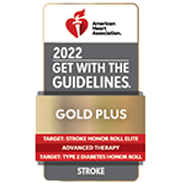Stroke Care
Stroke occurs when a blood vessel is blocked by a clot (an "ischemic" stroke) or when a blood vessel in the brain ruptures ("hemorrhagic" stroke). When a stroke happens, the brain damage that occurs can set off a cascade of other complications. That's why it's so important to treat a stroke as soon as possible. NewYork-Presbyterian Westchester (formerly Lawrence Hospital) has the specialized expertise needed to quickly evaluate patients with stroke symptoms and treat them promptly using the latest therapies to optimize recovery. We have onsite imaging, the latest treatments, and a team of specially trained doctors—all available onsite. Our team determines the type of stroke and its severity, and customizes a plan of care for each of our patients.
The Stroke Treatment Team
Our stroke care team brings together professionals from various hospital departments to give patients the best chance of an excellent recovery. From prompt evaluation and treatment in the Emergency Department to coordinated care provided by doctors and nurses from neurology, interventional neurology, radiology, the Catheterization Lab, and the Intensive Care Unit, patients can receive all the care they need quickly, seamlessly, and in one location.
Onsite Evaluation
Our Emergency Department has a computed tomography (CT) scanner onsite for the rapid assessment of patients with stroke. The team can perform CT angiography and CT perfusion—imaging exams to look at the flow of blood in the brain—to diagnose strokes, including their type and location. The results of this testing enable our doctors to customize the most effective care for each patient.
Care For Ischemic Stroke
Our team offers both medical and interventional treatments for ischemic stroke, such as:
- Tissue plasminogen activator (tPA), a clot-busting drug, which is effective when given within four-and-a-half hours of the onset of stroke symptoms in people who do not have bleeding in the brain. We give tPA rapidly to patients with ischemic stroke who arrive in our Emergency Department. This timing is critical for achieving better outcomes.
- Minimally invasive treatment. Endovascular treatment is used for ischemic strokes that do not resolve with tPA in patients with large blockages in the blood vessels in the brain, as well as in patients for whom tPA is no longer a treatment option. In collaboration with NewYork-Presbyterian/Columbia University Irving Medical Center physicians, we use "mechanical clot extraction," inserting a special device through a catheter (flexible tube) advanced to the site of the blockage to remove the clot and restore blood flow. The doctor can also insert a stent (a small mesh tube) to hold the artery open after the blockage is removed to maintain blood flow.
Care For Hemorrhagic Stroke
To protect brain tissue, patients experiencing bleeding in the brain may receive care to control high blood pressure, normalize blood clotting, control brain swelling, and enhance the flow of oxygen-rich blood to brain tissue near the injury. Depending on the size of the stroke, patients may be transferred to NewYork-Presbyterian/Columbia if they are in need of more advanced care.
Awards and Recognition

NYP Westchester is designated by the New York State Department of Health as a Primary Stroke Center. In recognition of our exceptional and prompt stroke care, we received the Get with the Guidelines®-Gold Plus Award and Target Stroke Elite Honor Roll Award from the American Heart Association and American Stroke Association.


